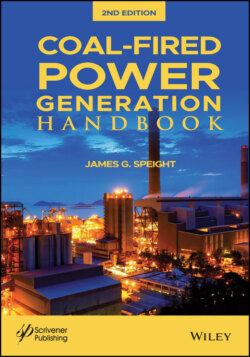Читать книгу Coal-Fired Power Generation Handbook - James Speight G., James G. Speight - Страница 76
3.6.3 Microwave Dryers
ОглавлениеThere has been, and continues to be, high interest in the utilization of microwave. Such overwhelming interest is understandable considering the advantages microwave-related drying systems offer over conventional ones. Conventional drying methods employ surface heating, and are generally a slow process since the rate of heat transfer from the surface to the core of the material is dependent on (i) the process parameters, (ii) the particle size of the coal, and (iii) the properties or type of the coal.
In microwave heating, volumetric heating is achieved and energy is preferentially transferred to moisture in the material without the need to heat the material first, resulting in shorter drying time. Capital and operating costs due to use of the highest form of energy (electricity) in microwave drying remain an impediment despite its technical advantages. It has been reported that the use of microwave energy for drying coal can also result in hot spots and, thus, local overheating of the coal and can be a disadvantage in the selection of this type of dryer for coal application (Osman et al., 2011).
In most microwave drying applications, the feed is usually not stationary – microwave heating is known to be uneven, and tends to form regions of underexposure (cold spots) and overexposure (hot spots). By keeping the material in constant motion relative to the microwave-guides, more even heating can be achieved. This relative movement is usually achieved by placing the material on a rotating plate or conveyor, and passing it under the microwave guides.
Advantages of microwave heating can be accrued in one of three ways: (i) as a pre-dryer, (ii) as a booster dryer, or (iii) as a post-dryer. When used as a pre-dryer, volumetric heating due to microwave quickly forces internal moisture to the surface, facilitating the optimal operation of a conventional dryer. In booster drying, microwave energy is added as the drying rate begins to fall off, thereby sustaining or even increasing the drying rate. When used as a post-dryer, the microwave system greatly improves drying efficiency of the conventional dryer since the last one-third of water is most difficult to remove by the conventional dryer alone.
Microwave drying also produces clean coal with low-sulfur content using the ability to preferentially direct the microwave energy at the pyrite (FeS2) in coal giving rise to localized thermo-desulfurization reaction between pyritic sulfur and other neighboring reactive compounds present in the solid (Weng and Wang, 1992). The polarization of microwave fields results in the cleavage of the iron-sulfur bonds, releasing sulfur in the form of hydrogen sulfide (H2S), carbonyl sulfide (COS), or sulfur dioxide (SO2).
